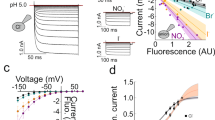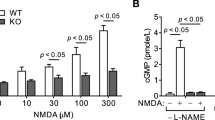Abstract
The release of glutamate during brain anoxia or ischaemia triggers the death of neurons1, causing mental or physical handicap. The mechanism of glutamate release is controversial, however. Four release mechanisms have been postulated: vesicular release dependent on external calcium2 or Ca2+ released from intracellular stores3; release through swelling-activated anion channels4; an indomethacin-sensitive process in astrocytes5,6,7; and reversed operation of glutamate transporters8,9. Here we have mimicked severe ischaemia in hippocampal slices and monitored glutamate release as a receptor-gated current in the CA1 pyramidal cells that are killed preferentially in ischaemic hippocampus. Using blockers of the different release mechanisms, we demonstrate that glutamate release is largely by reversed operation of neuronal glutamate transporters, and that it plays a key role in generating the anoxic depolarization that abolishes information processing in the central nervous system a few minutes after the start of ischaemia. A mathematical model incorporating K+ channels, reversible uptake carriers and NMDA (N-methyl- D-aspartate) receptor channels reproduces the main features of the response to ischaemia. Thus, transporter-mediated glutamate homeostasis fails dramatically in ischaemia: instead of removing extracellular glutamate to protect neurons, transporters release glutamate, triggering neuronal death.
This is a preview of subscription content, access via your institution
Access options
Subscribe to this journal
Receive 51 print issues and online access
$199.00 per year
only $3.90 per issue
Buy this article
- Purchase on Springer Link
- Instant access to full article PDF
Prices may be subject to local taxes which are calculated during checkout






Similar content being viewed by others
References
Choi, D. W. & Rothman, S. M. The role of glutamate neurotoxicity in hypoxic-ischemic neuronal death. Annu. Rev. Neurosci. 13, 171–182 (1990).
Drejer, J., Benveniste, H., Diemer, N. H. & Schousboe, A. Cellular origin of ischemia-induced glutamate release from brain tissue in vivo and in vitro. J. Neurochem. 45, 145 –151 (1985).
Katchman, A. N. & Hershkowitz, N. Early anoxia-induced vesicular glutamate release results from mobilization of calcium from intracellular stores. J. Neurophysiol. 70, 1– 7 (1993).
Bednar, M. M., Kohut, J. J., Kimelberg, H. K., Gross, J. J. & Gross, C. E. In vitro evidence supporting two mechanisms of action for the anion transport inhibitor L-644,711 in cerebral ischaemia. Neurol. Res. 14, 53– 56 (1992).
Parpura, V. et al. Glutamate-mediated astrocyte–neuron signalling. Nature 369, 744–747 ( 1994).
Hassinger, T. D. et al. Evidence for glutamate-mediated activation of hippocampal neurons by glial calcium waves. J. Neurobiol. 28, 159–170 (1995).
Bezzi, P. et al. Prostaglandins stimulate calcium-dependent glutamate release in astrocytes. Nature 391, 281– 285 (1998).
Szatkowski, M., Barbour, B. & Attwell, D. Nonvesicular release of glutamate from glial cells by reversed electrogenic glutamate uptake. Nature 348, 443–446 (1990).
Szatkowski, M. & Attwell, D. Triggering and execution of neuronal death in brain ischaemia: two phases of glutamate release by different mechanisms. Trends Neurosci. 17, 359– 365 (1994).
Hansen, A. J. Effect of anoxia on ion distribution in the brain. Physiol. Rev. 65, 101–148 ( 1985).
Basarsky, T. A., Feighan, D. & MacVicar, B. A. Glutamate release through volume-activated channels during spreading depression. J. Neurosci. 19, 6439–6445 (1999).
Lerma, J. & Martin del Rio, R. Chloride transport blockers prevent N-methyl-D-aspartate receptor-channel complex activation. Mol. Pharmacol. 41, 217–222 (1992).
Walz, W., Klimaszewski, A. & Paterson, I. A. Glial swelling in ischemia: a hypothesis. Dev. Neurosci. 15, 216–225 (1993).
Sarantis, M. et al. Glutamate uptake from the synaptic cleft does not shape the decay of the non-NMDA component of the synaptic current. Neuron 11, 541–549 ( 1993).
Spruston, N., Jonas, P. & Sakmann, B. Dendritic glutamate receptor channels in rat hippocampal CA3 and CA1 pyramidal neurons. J. Physiol. (Lond.) 482, 325–352 (1995).
Madl, J. E. & Burgesser, K. Adenosine triphosphate depletion reverses sodium-dependent, neuronal uptake of glutamate in rat hippocampal slices. J. Neurosci. 13, 4429– 4444 (1993).
Storm-Mathiesen, J. et al. Ultrastructural immunocytochemical observations on the localization, metabolism and transport of glutamate in normal and ischemic brain tissue. Prog. Brain Res. 94, 225– 241 (1992).
Attwell, D., Barbour, B. & Szatkowski, M. Nonvesicular release of neurotransmitter. Neuron 11, 401–407 ( 1993).
Levy, L. M., Warr, O. & Attwell, D. Stoichiometry of the glial glutamate transporter GLT-1 expressed inducibly in a CHO cell line selected for low endogenous Na+-dependent glutamate uptake. J. Neurosci. 18, 9620–9628 (1998).
Gundersen, V., Danbolt, N. C., Ottersen, O. P. & Storm-Mathisen, J. Demonstration of glutamate/aspartate uptake activity in nerve endings by use of antibodies recognizing exogenous D-aspartate. Neuroscience 57, 97–111 (1993).
Zerangue, N. & Kavanaugh, M. P. Flux coupling in a neuronal glutamate transporter. Nature 383, 634– 637 (1996).
Billups, B. & Attwell, D. Modulation of non-vesicular glutamate release by pH. Nature 379, 171– 174 (1996).
Sah, P., Gibb, A. J. & Gage, P. W. Potassium current activated by depolarization of dissociated neurons from adult guinea pig hippocampus. J. Gen. Physiol. 92, 263–278 (1988).
Nowicky, A. V. & Duchen, M. R. Changes in [Ca2+]i and membrane currents during impaired mitochondrial metabolism in dissociated rat hippocampal neurons. J. Physiol. (Lond.) 507, 131–145 ( 1998).
Jahr, C. E. & Stevens, C. F. Voltage dependence of NMDA-activated macroscopic conductances predicted by single-channel kinetics. J. Neurosci. 10, 3178–3182 (1990).
Patneau, D. K. & Mayer, M. L. Structure-activity relationships for amino acid transmitter candidates acting at N-methyl-D-aspartate and quisqualate receptors. J. Neurosci. 10, 2385–2399 (1990).
Raley, K. M. & Lipton, P. NMDA receptor activation accelerates ischemic energy depletion in the hippocampal slice and the demonstration of a threshold for ischemic damage to protein synthesis. Neurosci. Lett. 110, 118–123 ( 1990).
Friedman, J. E. & Haddad, G. G. Anoxia induces an increase in intracellular sodium in rat central neurons in vitro. Brain Res. 663, 329–334 (1994).
McBain, C. J., Traynelis, S. F. & Dingledine, R. Regional variation of extracellular space in the hippocampus. Science 249, 674–677 (1990).
Roettger, V. & Lipton, P. Mechanism of glutamate release from rat hippocampal slices during in vitro ischemia. Neuroscience 75, 677–685 (1996).
Acknowledgements
We thank E. Rutledge and H. Kimelberg for providing L-644,711, and J. Ashmore, P. Behe, S. Brickley, B. Clark, D. Colquhoun, F. Edwards, M. Farrant, A. Gibb, M. Hamann, M. Häusser and A. Silver for comments on the manuscript. This work was supported by the Wellcome Trust, European Community and the Shionogi Company Ltd.
Author information
Authors and Affiliations
Corresponding author
Rights and permissions
About this article
Cite this article
Rossi, D., Oshima, T. & Attwell, D. Glutamate release in severe brain ischaemia is mainly by reversed uptake . Nature 403, 316–321 (2000). https://doi.org/10.1038/35002090
Received:
Accepted:
Issue Date:
DOI: https://doi.org/10.1038/35002090
This article is cited by
-
BCAT1 controls embryonic neural stem cells proliferation and differentiation in the upper layer neurons
Molecular Brain (2023)
-
Extrasynaptic NMDA receptors in acute and chronic excitotoxicity: implications for preventive treatments of ischemic stroke and late-onset Alzheimer’s disease
Molecular Neurodegeneration (2023)
-
Synaptic modifications transform neural networks to function without oxygen
BMC Biology (2023)
-
Energy optimisation predicts the capacity of ion buffering in the brain
Biological Cybernetics (2023)
-
An Updated Review of Mitochondrial Transplantation as a Potential Therapeutic Strategy Against Cerebral Ischemia and Cerebral Ischemia/Reperfusion Injury
Molecular Neurobiology (2023)
Comments
By submitting a comment you agree to abide by our Terms and Community Guidelines. If you find something abusive or that does not comply with our terms or guidelines please flag it as inappropriate.



